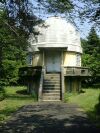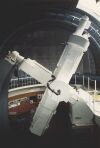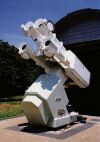
[Japanese/ English]
|
National Astronomical Observatory of Japan and its predecessor (Tokyo Astronomical Observatory of the University of Tokyo) have been conducting observations of various activity indices of the sun. The peak of solar activity, indicated by numerous sunspots and frequent flare explosions, comes every 10-11 years. This periodicity is sometimes disturbed; for example in the 17-th century there was a period of about 50 years in which the solar activity was unusually low. In order to investigate such a long time scale variation of the sun, persistent observations of the sun and systematic accumulation of data are crucial. This CDROM contains data taken mainly in the period of 1990-2002. Two international programs, namely STEP (Solar Terrestrial Energy Program: 1990-1997) and S-RAMP (STEP-Results, Applications, and Modeling Phase: 1998-2002), were carried out in this period. Many institutions around the world cooperated and studied the effects of the sun's variability on the environment of the earth. The construction of this database has been financially supported in part by the Grant-in-Aid for Scientific Research (from the Ministry of Education and from the Japan Society for the Promotion of Science), 'Database from S-RAMP International Cooperation Program' (led by Dr. Tatsuki Ogino, Solar-Terrestrial Environment Laboratory, Nagoya University, 1998, 2000-2002). When you intend to publish an article
based on these data, you are requested to contact us at: |
The images can be searched by specifying the date.
| Solar Flare Telescope | |||
| The
Solar Flare Telescope is located at the north-west section of the Mitaka
campus. It is made of four telescopes (15cm and 20cm aperture, two of
each) and observes magnetic fields, velocity fields, sunspot structures,
and flares in H-alpha light. Details |
|||
| Instruments and Examples of Data | |||
| Publications | |||
|
|
|||
 |
Sunspot Telescope | ||
| Sunspot
observations at Mitaka have been conducted with a 20cm aperture refractor
made by Zeiss (installed in 1938). The solar image with a diameter of
24cm is projected onto a sheet of paper, and sunspots and faculae are
sketched. Details |
|||
| Results | |||
| Browse Data | |||
| Publications | |||
|
|
|||
 |
New Sunspot Telescope | ||
| Replacing
the sunspot sketch observations which had been conducted for more than
60 years, the New Sunspot Telescope is equipped with a 2K X 2K pixel CCD
camera and takes digital images of the full solar disk. Details |
|||
| Browse Data | |||
| Publications | |||
|
|
|||
 |
Flare Patrol Telescope | ||
| The
Flare Patrol Telescope takes digitized H-alpha images of the solar disk
every one minute. When a flare is detected, a one-second cadence data
recording starts automatically. Details |
|||
| Browse Data | |||
| Publications | |||
|
|
|||
 |
STEP Full-Disk Magnetograph | ||
| This
instrument was developed for the international STEP program, and takes
the magnetic maps of the full solar disk. Details |
|||
| Browse Data | |||
| Publications | |||
|
|
|||
 |
10cm Coronagraph | ||
| This
telescope was built in 1950, and visual observations of the intensity
of coronal green emission line had been carried out till 1997. The telescope
was upgraded in 1997 and now digital images of the green line corona are
obtained by using a birefringent filter and a CCD camera. Details |
|||
| Results | |||
| Browse Data (Green Line) | |||
| Publications | |||
|
|
|||
 |
25cm Coronagraph | ||
|
This telescope uses a coude system and
the solar beam is fed through the polar axis to the spectrograph room
next to the dome. A large grating provides high dispersion spectra of
the sun. |
|||
| Examples of Data | |||
| Browse Data (10830 Angstrom Line) | |||
| Publications | |||
